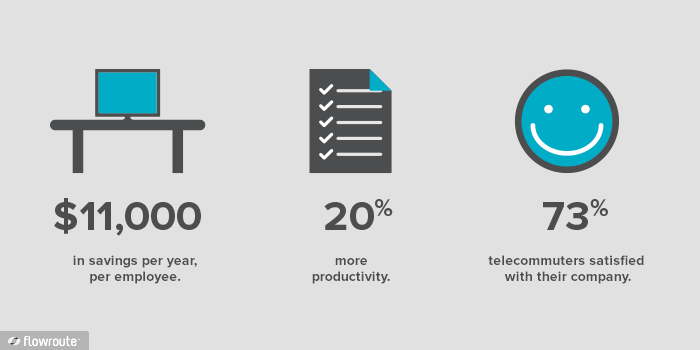Forbes says, “Telecommuting Is The Future of Work.” And they’re right. In the past two years the popularity of telecommuting has risen by 20%. Nearly a quarter of American workers spend at least some of their work week telecommuting. From a business perspective, the case for outweighs any argument against. Establishing the infrastructure and protocols to support a more virtual workforce before they go work for someone who already has, will save you time, headaches, and customers.
All the right reasons
Technology lets us connect and collaborate from anywhere in the world. Remote and virtual employees allow companies to be more productive by literally working around the clock. It also lifts talent restrictions that previously limited your pool to those in your area and anyone willing to relocate there.
Productivity and access to the global talent pool are awesome, but there are even more reasons to empower your employees with a pro-telecommuting policy.
Economic efficiency:
ZDNet says, “Employees who telecommute spend less money on transportation, clothes, food, and child care…” Inc. puts the annual employee savings somewhere between $2,000 and $7,000. ZDNet also points out that, employers save on office space, furnishings, maintenance, parking, and other opex, to a total Inc. places around $11,000 per year per employee.
Reduced footprint:
It’s good for the globe, too. I haven’t seen the calculations, but ZDNet claims that, if US employees with telecommutable jobs worked half their time from home, America would collectively save more than $700 billion, or 37 percent of oil imports from the Persian Gulf.
Woah.
Productivity:
When working from home on creative tasks, workers are up to 20 percent more productive. And, 90 percent (that’s almost all…) of managers believe their people are more productive when they have the flexibility to choose when and how they work, i.e. from home.
Loyalty:
Evidence shows that workers who telecommute are happier in their jobs. 73 percent are satisfied with their company. We all know happier employees lower your training budget significantly, and build better client relationships by not restarting the rapport building process every time a recruiter fires up LinkedIn.
So, how do you do it?
Modern communications technology makes the telecommute easy. Unified Communications platforms can deliver real flexibility to your workforce and add strong collaboration tools for remote and virtual teams. The phone system and service provider you use can be instrumental in empowering your workforce to enjoy all the benefits of working remotely by enabling easy forwarding and mobile integration. In particular, SIP trunking can provide a versatile connection that workers can take with them anywhere at the click of a switch.
From an individual perspective, there are many applications that are capitalizing on the shift with productivity tools people can use to better stay on task when working from home. You can help enable your team by integrating these types of tools and services into your organization.
- Consolidators like Trillian consolidate IM tools under one umbrella. So users get a single tool to simultaneously communicate to different colleagues over Yahoo Instant Messenger, Google Talk, MSN Messenger, and more.
- Collaboration enablers like Google+ Hangouts deliver a straight one-on-one communications tool, and a robust collaboration tool that brings together team members from all over the world on one document. Others like Join.me provide screen sharing for walk throughs, and remote support.
- Other apps like Focus Time and countless others help workers schedule focused time that’s rewarded with breaks.
- Employees can self restrict access to all the classic productivity wasters like Facebook, Buzzfeed, and Will it Blend videos.
- Time tracking apps measure screen time for other applications, tools, and websites to track where you’re spending your time, and can even alert you if you’ve been reading celebrity gossip too long.
- Cloud-based file sharing tools like Dropbox, Box, and Copy, make remote access, editing, and sharing foolishly easy. Internal server access is no longer a barrier to mobility.
“Commutication” is key
Keeping in touch with your people to facilitate productivity and collaboration, is crucial to making telecommuting work. Establishing expectations, and holding your nomadic workforce accountable are important components of a functioning policy.
It’s not enough to yell, “Go!” Beyond a clear policy, your people need the means to connect. We live in a world where call centers can be an abstract concept referring to a globally distributed team that needs only a headset and an Internet connection. As voice data is treated more and more like data data, it becomes possible to manipulate it and transport it in new, interesting, and productive ways. The right tools will open up your world in terms of productivity, flexibility, responsiveness. You can hire based solely on merit, with little consideration for geographic positioning. And you get to cut costs by containing physical office space while reducing employee turnover.
To manage a telecommuting workforce, your phone system needs to be responsive, with real time activation of new services, settings and features. To accommodate secure entry, you also need strict security rules, and account-level toll-fraud protection. Once your system is set up to facilitate connections from anywhere the benefits of telecommuting will start to pile up.







